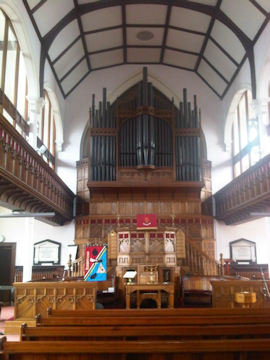
 |
Cumbrian Society of Organists |
This year's concert took place at the United Reformed Church in Whitehaven.
Beginning in the late renaissance with Marjorie Harrison playing an organ voluntary by Thomas Weelkes (1575–1621), the event aimed to demonstrate how the organ and its music evolved from the 16th to the 21st century. Weelkes composed madrigals and anthems for the church. Like his contemporaries he was inspired by the street songs of traders advertising their wares. He would take a simple melody and arrange it into four part harmony. One can almost hear the street cries in this simple voluntary. This music was probably performed on a house organ.
Ian Hare as compère seamlessly moved us on to Italy and Giralamo Frescobaldi. Madge Leeming performed two of his organ compositions. La Frescobalda followed by Corrente e Canzona. Frescobaldi was a master of counterpoint and Madge demonstrated this in her performance. I find it difficult to classify Frescobaldi, he is definitely post renaissance but seems to be pre Baroque. This leads us into the Baroque Era and J. S. Bach.
Bach (1685–1750) was influenced by Frescobaldi’s composition of mass settings “Fiori Musicali.” He copied the scores and studied them. Ian Hare played “Jesus Christus, unser Heiland”. This music contrasted sharply with what had gone before. The texture was thicker and Ian was able to register the organ and provide tonal contrasts. Also evident was the use of the foot pedal. Needless to say Ian gave a superb performance.
Moving on from Bach’s organ Chorale and Prelude, Mike Town took us dancing. The audience tapped their feet to the rhythm of Mike’s lively rendition of the Voluntary in G major by John Garth. (1722–1810). This composer was born in Durham.
We then entered the realm of Victoriana. 1809–1847, the era of Mendelssohn. David Shingler did us proud by his stately rendition of Sonata No.2 in C. As a composer Mendelssohn liked to set a strict tempo for each movement of his music and he would stick to it rigorously. David adhered to this admirably and his footwork was amazing covering a most demanding pedal part. The organs in the Mendelssohnian era had no means of creating dynamics, it was all in the registration.
Richard Brice brought us into the 20th century with “Willow the Wisp”, a piece written for organ by American composer G. B. Nevin, brother of Ethelbert. Richard’s nimble fingers captured the spirit of the Wisp perfectly.
Ian followed with “Song of Sunshine” by Alfred Hollins. Fiendishly difficult to play but Ian made it look easy and he played with great panache. Alfred Hollins was influential in the design of the organ for The United Reformed Church in Whitehaven.
Michael Farrer then played “Master Tallis’s Testament” by Herbert Howells (1892–1983). This was exquisite. Michael played with such sensitivity and with full control of the tonal effects and dynamic range of the organ.
Adrian Self brought us into the 21st century. A few days previously he composed a suite of five movements which he named “Cambridge Capers”. Adrian played three of them. Movement 1 “Afternoon tea at the Old Vicarage, Grantchester”. (The music wittily references the theme tune of “The Archers”.) Movement 3, “Ely Imps”, portraying naughty little boy choristers, and movement 4 named “Bedells” is illustrative of academics dressed in their gowns parading through the streets of Oxford.
Frank Bowler played a brilliant composition by Norwegian Composer Mons Leidvin Takle, “Power of Life” from “Festivity”. This pulled out all the stops and made a fitting end to the day.
Finally I would like to thank all the organists who gave up their time and helped make the event a success. Some of the performers travelled many miles and incurred significant expense to attend. I extend a special thank you to them. 10 organist’s played and there was an audience of about 30.

National Pipe Organ Register Links